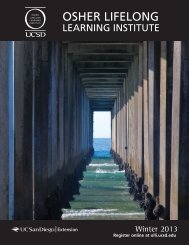1 The Living Art of Greek Tragedy Marianne McDonald, Ph.D., MRIA ...
1 The Living Art of Greek Tragedy Marianne McDonald, Ph.D., MRIA ...
1 The Living Art of Greek Tragedy Marianne McDonald, Ph.D., MRIA ...
Create successful ePaper yourself
Turn your PDF publications into a flip-book with our unique Google optimized e-Paper software.
What I shall do is <strong>of</strong>fer a short practical guide that gives suggestions, and general<br />
information, but not prescriptions. I shall begin with some background for the thirty-two <strong>Greek</strong><br />
tragedies and the one satyr play which survive. I shall touch on the plot, some <strong>of</strong> the ideas, and<br />
make some suggestions about performance. <strong>The</strong> translations are my own. I shall also include<br />
some information about some <strong>of</strong> the most significant modern versions and performances, besides<br />
a short bibliography. <strong>The</strong>re is no study yet in English that covers the major versions available.<br />
This small book should serve as a stepping-stone for directors, playwrights, actors,<br />
designers and others in the theatre who would like a brief introduction to the world <strong>of</strong> <strong>Greek</strong><br />
tragedy, and some <strong>of</strong> the works it has inspired. By giving brief plot summaries this facilitates<br />
choice <strong>of</strong> text. In the sections on the plays, I shall refer to some recent productions, and list even<br />
more in the section called Performance Tradition. I shall select a few for more detailed<br />
descriptions. For instance, in the sections about versions by Seneca (c. 3 BC-65 AD), the<br />
individual plays will be arranged chronologically following the chronology <strong>of</strong> the modern<br />
versions, and then arranged according to plays, i.e., if Seneca had a Medea (which he did), I<br />
include this as the earliest surviving version after Euripides. <strong>The</strong> later versions <strong>of</strong> Medea follow.<br />
Since Seneca had no version <strong>of</strong> Alcestis, in this section Alcestis comes after Medea, although<br />
Euripides wrote Medea earlier. <strong>The</strong>n some more versions <strong>of</strong> Alcestis are arranged together. <strong>The</strong><br />
arrangement is both chronological and thematic where possible.<br />
<strong>Greek</strong> tragedy has something to say to everyone. <strong>Greek</strong> tragedy raises questions, and<br />
suggests answers, but never insists. What these magnificent plays do is let us look at our deepest<br />
fears and continue to live in spite <strong>of</strong> them. <strong>The</strong>se fears can come from circumstances that are<br />
external to us: the threat <strong>of</strong> war; the threat <strong>of</strong> Anthrax poisoning; the threat <strong>of</strong> a crippling or fatal<br />
disease; living with poverty, or under an oppressive government. <strong>The</strong>n there are the internal<br />
reasons for fear: that clock ticking inside <strong>of</strong> us all that tells us that we shall not live forever. <strong>The</strong><br />
fear <strong>of</strong> death can be crippling, or, if we believe the existentialists, liberating.<br />
Nietzsche used the image <strong>of</strong> Perseus, the <strong>Greek</strong> hero who slew the Gorgon Medusa,<br />
fierce with her head <strong>of</strong> snakes. If a person looked at her directly, he would be turned to stone.<br />
4









